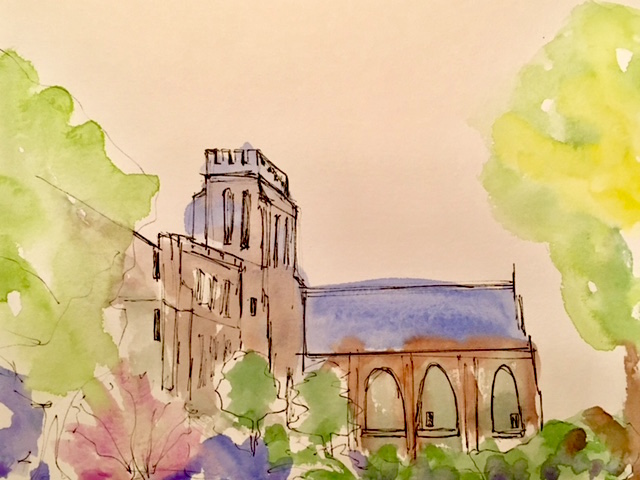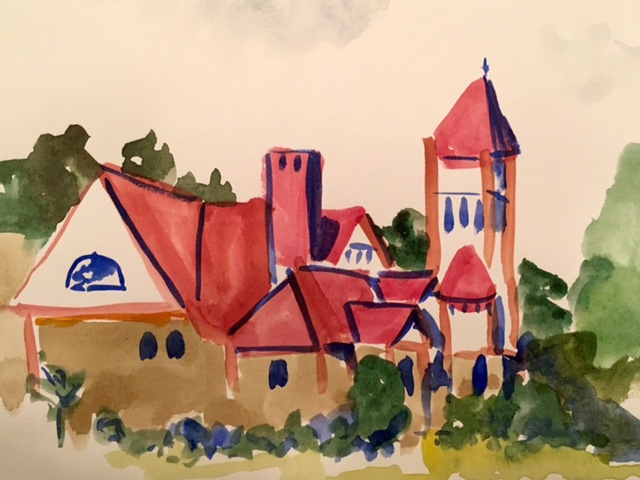182 Structures Now Under Consideration for “Historic” Designation

Belmont Methodist Church on Common Street, an example of Gothic Revival architecture, is on the list of buildings designated for review by the Historic District Commission.
by Sharon Vanderslice
Belmont’s historic districts preserve many of the town’s historic buildings, which contribute dramatically to its sense of place. But many other important buildings are outside the districts. To protect them, Belmont Town Meeting has now required a one-year delay before anyone can get a permit to demolish 182 historically or architecturally significant buildings not otherwise protected.
The list of designated buildings was developed by the Historic District Commission (HDC) from information prepared by a preservation consultant and funded by a 2013 Belmont Community Preservation Act grant. The list, approved by Town Meeting in May, replaced an expiring demolition delay bylaw that had protected 149 properties. The 2016 Historic Resources Survey by Lisa Mausolf updated a survey of significant Belmont properties done by Boston University between 1979 and 1982 when the primarily 19th-century Pleasant Street Historic District was established. The 1984 Belmont: The Architecture and Development of the Town of Homes, known locally as the Green Book, was based on the BU survey.

The First Church in Belmont Unitarian Universalist on Concord Avenue, a Richardsonian Romanesque design, is on the list for historic preservation review.
The new survey evaluated properties that had previously been ignored, including mid-20th-century buildings such as the Walter Gropius-designed home at 69 Pinehurst Road, post-war commercial buildings such as the 105-115 Trapelo Road block in Cushing Square, and Belmont Hill properties such as the magnificent Tudor Revival home at 191 Clifton Street, according to HDC co-chair Lauren Meier. Twenty-four buildings on the list are considered candidates for the National Register of Historic Places.
In the wake of neighborhood uproar over the demolition of both the Waverley Square Congregational Church and the Arts & Crafts rectory of Our Lady of Mercy Church in 2010, eight Belmont churches are on the list of historic buildings subject to demolition review. They are the 1912 Gothic Revival Saint Joseph’s Church and the 1922 Gothic Revival Belmont Methodist Church on Common Street, the 1890 Richardsonian Romanesque First Church at 404 Concord Avenue, the 1912 Mission-style Saint Andrew’s Episcopal Church at 21 Marlboro Street, the Gothic Revival Saint Luke’s Church at 132 Lexington Street, the 1904 English Revival First Baptist Church at 129 Lexington Street, the 1915 neo-Gothic Revival Payson Park Congregational at 351 Belmont Street, and the 1897 English Revival All Saints Church, rectory, and hall at 69 Common Street.
“What this bylaw provides is a small bit of protection for buildings not already protected by other means.”
Belmont’s Distinctive Buildings
“The town of Belmont is a highly desirable place to live and work, largely due to the quality and quantity of distinctive historic properties like these,” explains HDC co-chair and architectural conservator Lisa Harrington. “They give the community a character that is irreplaceable.”
“What this bylaw provides is a small bit of protection for buildings not already protected by other means,” says Meier, whose own home is on the list. If an owner wishes to demolish a building on the list, he or she must first apply for a permit from the Office of Community Development, as is required for any building project. The town then notifies the community of a pending demolition and the HDC holds a public hearing to determine whether the building is “preferably preserved.” If it is so designated, the owner must wait up to 12 months before demolishing the building. This delay provides time to explore alternatives to demolition—including, for instance, conversion to condominiums (as was done with the old Waverley Square fire station) or re-use of accessory buildings (as was done with the renovated barn at 5 Somerset Street). The delay allows the neighborhood to weigh in on viable options.
The HDC may waive or reduce the delay period. Owners who demolish their historically significant building without following the bylaw are fined $300 per day for up to one year. Owners who believe that their property was mistakenly included on the review list may file an appeal with Belmont’s Office of Community Development within 60 days after the bylaw receives final approval from the Massachusetts attorney general. (As of this writing, the AG’s office has not responded to the proposal, and might not until October, according to Spencer Gober, staff planner in the Belmont Community Development office.)
Owners who demolish their historically significant building without following the bylaw are fined $300 per day for up to one year.
On appeal, the Board of Selectmen would make the final decision on applicability.
At a public hearing before the Town Meeting vote this past spring, homeowners raised questions about the impact of a demolition delay bylaw on their property values and the effect it would have on any desired renovations. “A lot of evidence exists that preservation enhances property values,” Meier says. The bylaw places no restrictions on renovations, she added. A homeowner could, for instance, rip out exterior architectural details, replace windows, or remove porches, dormers, and additions.
“You can’t really replace these homes with new construction. These old homes were built to last.”
In fact, says Meier, a more durable form of preservation would utilize other kinds of planning tools including designated neighborhood conservation districts or zoning rules that would protect neighborhoods from incompatible development. The bylaw is a balance between preserving the character of the town and preserving the rights of owners.
“You can’t really replace these homes with new construction,” Meier adds. “These old homes were built to last.”
Preservation is a Sound Investment
HDC co-chair Harrington references a 2005 Brookings Institution paper by Randall Mason of the University of Pennsylvania that reviewed dozens of studies on the economics of preservation. “Historic preservation,” it concluded, “is typically judged to be a sound investment. By most accounts, it is more efficient and profitable to preserve a historic building than to construct a new one.” The relative cost savings of rehabilitation can range from 3 to 16%, according to real estate and preservation expert Donovan Rypkema.
Mason cited an exhaustive 2001 study of cities in Texas, which found that historic designation increased property values in the range of 5 to 20%. Another 2003 study of New York City buildings found that local historic district designation and regulation resulted in real estate price premiums ranging from 22.6 to 71.8%.
Another HDC member, local realtor Terry McCarthy, said that so far, based on a small sample of eight homes that were on Belmont’s demo delay list and sold since 2013, the effect of the bylaw on sales has been small. “Single-family homes listed for over $700,000 and not on the demo delay list sold for 101 percent of their list price within an average of 30 days, while the single-family homes that were on the demo delay list and sold during the same time frame and were also listed for over $700,000 sold for an average of 100 percent of their list price within an average of 34 days,” she notes.
Mason cited an exhaustive 2001 study of cities in Texas, which found that historic designation increased property values in the range of 5 to 20%.
When compared with demolition delay bylaws in nearby towns, Belmont’s is considered lenient. For one thing, it has a five-year sunset provision that would require Town Meeting to vote to renew it in the near future. “The five-year sunset clause likely reflects the difficulty of getting historic preservation (or anything that limits property rights) through Town Meeting,” according to Sue Bass (a longtime Precinct 3 TMM). The bylaw that it replaces also had a sunset clause, originally 2016, which received a one-year extension because the study took longer than expected.
The bylaw also applies to a narrowly defined list of buildings and excludes all municipal buildings. In contrast, Newton’s bylaw covers any structure 50 years or older and Wellesley’s bylaw applies to any dwelling built prior to 1950. Arlington also has a robust bylaw, in addition to many designated historic districts.
When compared with demolition delay bylaws in nearby towns, Belmont’s is considered lenient. For one thing, it has a five-year sunset provision that would require Town Meeting to vote to renew it in the near future.
“What’s on our updated list is not a complete list of historically or architecturally significant buildings in the town,” says Meier, but is “representative of the most important unprotected historic buildings that illustrate the range of styles and periods in Belmont.”
To view the entire survey of buildings subject to demolition delay, which date from 1700 to 1948, you may visit the town of Belmont website: http://bit.ly/2xPjmx5
Sharon Vanderslice is a former Town Meeting member, a former member of the Historic District Commission, and the founding editor of the Belmont Citizens Forum Newsletter.


Sorry, the comment form is closed at this time.